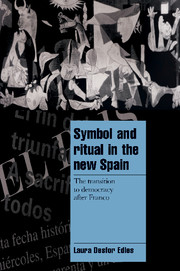Book contents
- Frontmatter
- Contents
- List of tables
- List of figures
- List of abbreviations
- Acknowledgements
- Map of Spain
- Part I Interpreting the Spanish transition to democracy
- 1 Introduction
- 2 Theories of transition and transitions in theory
- 3 Spain: a history of divisions and democracy
- Part II The symbolic basis of Spanish consensus
- Part III Conflict and consensus in the institutionalization of Spanish democracy
- Notes
- References
- Index
3 - Spain: a history of divisions and democracy
Published online by Cambridge University Press: 06 July 2010
- Frontmatter
- Contents
- List of tables
- List of figures
- List of abbreviations
- Acknowledgements
- Map of Spain
- Part I Interpreting the Spanish transition to democracy
- 1 Introduction
- 2 Theories of transition and transitions in theory
- 3 Spain: a history of divisions and democracy
- Part II The symbolic basis of Spanish consensus
- Part III Conflict and consensus in the institutionalization of Spanish democracy
- Notes
- References
- Index
Summary
The sacred transitional representations that emerged and penetrated Spanish society after Franco's death were rooted deep in Spanish history. This is a history rife with religious, regional, and class divisions, and long epochs of political instability.
Early Spanish history
The Iberian peninsula has been inhabited and reinhabited by many different peoples in the last 5,000 years, and overall, as Strabo first noted, the Iberian peoples have tended to be “bad mixers.” In the third century, Roman legions came and captured the peninsula (which had been inhabited by Nordic Celts in the upper third of the Peninsula and tribes from Africa in the south) and dominated it for four centuries. The Romans were followed by various Germanic tribes, until the Arabs came and defeated the Germanic Visigoths in ad 711 and dominated the peninsula throughout the Middle Ages.
The Arabs failed however, to conquer the least Romanized peoples of the remote areas of the Cantabrian mountains. And it was in these mountains that the eight-century-long “Reconquista” or “Reconquest,” of the Iberian peninsula began. The Reconquista fused the two great driving forces of medieval times – war and religion – into one mammoth religious war. According to Crow, no other European country experienced a similar period.
In 1480, King Ferdinand and Isabella the Catholic attempted to complete the religious unity of Spain by setting up the infamous Spanish Inquisition.
- Type
- Chapter
- Information
- Symbol and Ritual in the New SpainThe Transition to Democracy after Franco, pp. 26 - 38Publisher: Cambridge University PressPrint publication year: 1998

